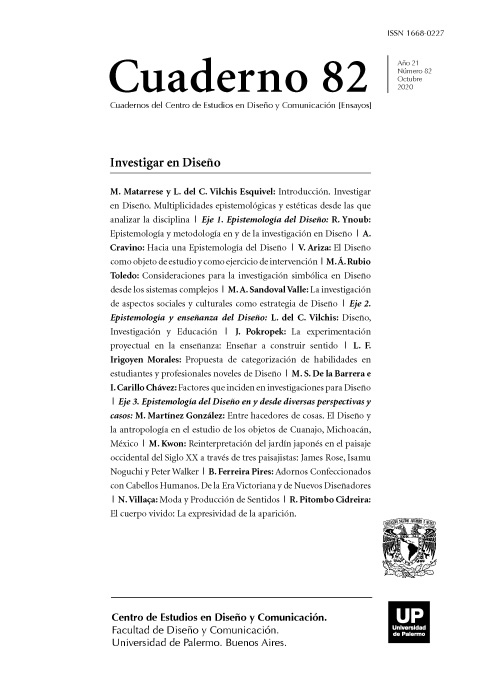La investigación de aspectos sociales y culturales como estrategia de Diseño
Abstract
It might indisputable for social and cultural aspects to be involved within design’s research and production strategy. In reality this does not necessarily happen, neither in the educational nor the professional spheres. There are constant conceptual and formal inconsistencies, motivated by economic pressures, professional limitations and demands of all kinds, although fundamentally defined by a paradigmatic vision that defines the scope of design’s research and execution. The following is a general characterization of the relationship that design research is estimated to have with the professional field, considering the realization of projects; the awareness of a method being used at the time of production and the registration process for the socialization of what is done. Emphasis is also placed on research description stemming from design sectors such as the academic and professional ones. Efforts are made to ponder design from a social perspective, since individuals are the fundamental reason of that which is planned and produced. When promptly thinking about culture and social order within design projects and research, it is possible to notice the inseparable influence of both aspects on strategic development, also determining the repercussions of its effectiveness. Three conceptual moments are addressed regarding design and research: their social condition; their external condition and their lack of substance. These moments are approached with sociological foundations as a starting point, in order to be consistent with the exhibition’s objectives, seeking to raise awareness and revalue the social aspects of the processes when executing and researching from within the subject area, thus seeking to bring design into the realm of social and cultural debate by ratifying it as a dynamic profession result of a series of collective traits, which helps to shape thoughts.
References
Bajtin, M. (2000). Yo también soy (Fragmentos sobre el otro). México: Taurus, Alfaguara.
Freidson, E. (2001). La teoría de las profesiones. Estado del arte. Perfiles Educativos, 23(93), 28-43.
Hillert. F. M. (2009). Sujetos sociales del campo profesional de la educación. Representaciones mutuas de los docentes y los especialistas en el contexto de las reformas educativas. Anuario 2008 del Instituto de Investigaciones en Ciencias de la Educación. Buenos Aires, Argentina: Editorial de la Facultad de Filosofía y Letras Universidad de Buenos Aires.
Lahire, B. (2006). ¿Para qué sirve la sociología? Argentina: Siglo XXI.
Lahire, B. (2016). En defensa de la sociología: Contra el mito de que los sociólogos son unos charlatanes, justifican a los delincuentes y distorsionan la realidad. Argentina: Siglo XXI.
López, C. (2015). Educar para la investigación-creación: áreas de trabajo, tipos de conocimiento y problemas de implementación. A Contratiempo. Recuperado de http://www.musigrafia.org/acontratiempo/?ediciones/revista-25/artculos/educar-para-la-investigacin-creacin-reas-de-trabajo-tipos-de-conocimiento-y-problemas-de-implementac.html.
Porter, M. (1996). What is Strategy? Harvard Business Review, noviembre-diciembre. Recuperado de: https://hbr.org/1996/11/what-is-strategy
Tapia, A. (2004). El Diseño Gráfico en el espacio social. México: Designio.
Urteaga, E. (2008). Sociología de las profesiones: una teoría de la complejidad. Lan Harremanak 18(2008-I), 169-198. Recuperado de www.ehu.eus/ojs/index.php/Lan_Harremanak/article/download/2812/2428
Los autores/as que publiquen en esta revista ceden los derechos de autor y de publicación a "Cuadernos del Centro de Estudios de Diseño y Comunicación", Aceptando el registro de su trabajo bajo una licencia de atribución de Creative Commons, que permite a terceros utilizar lo publicado siempre que de el crédito pertinente a los autores y a esta revista.


